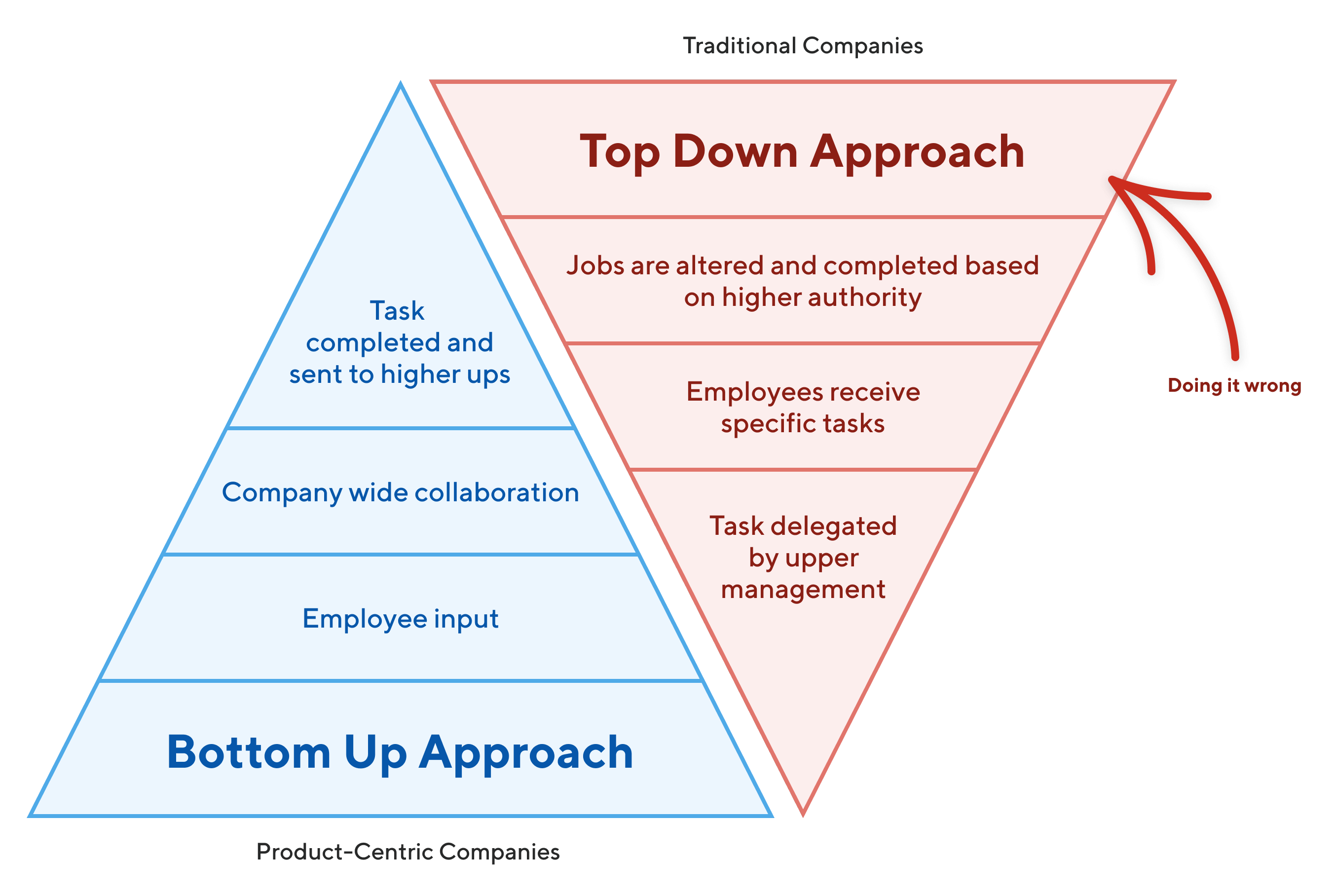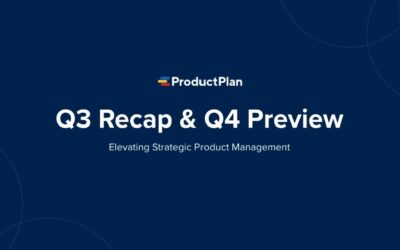The new year is right around the corner, and digital transformation continues to be the rage as companies evolve to seek relevance – modernizing systems, procedures, and mindsets for the modern world. CEOs tout the benefits and hype up their planning and investment. Product leaders swoop in to shepherd these efforts. Finally, customers eagerly await the benefits of the shift. Yet 80% of digital transformations fail. What’s causing so many failures? One key factor is a fundamental lack of understanding of product transformation relative to traditional operating models. Many leaders fail to realize that digital transformation must be synonymous with product transformation and the ability for an organization to be successful.
Remarkably, the COVID crisis accelerated the importance and availability of digital customer-facing touchpoints by five years. Companies that stayed on the sidelines face a major uphill battle when they decide to attempt a transformation strategy.
“The COVID crisis accelerated the importance and availability of digital customer-facing touch points by five years.”
For the small group of companies who successfully pivoted, will their product transformation continue or revert back to traditional ways of doing business? The global pandemic has taught us that businesses that remain agile and open to digital transformation will be successful, but that doesn’t guarantee changes in how a company operates.
Digital transformation and product development’s relationship
A strong response during a crisis isn’t a transformation but a reaction. And as soon as the dust settles, many companies risk going back to traditional ways of doing business. The status quo ultimately holds their transformation back. Why not leverage the new year to help your team adapt to this brand-new world?
First, break the mold of top-down management expectations
When facing intense adversity, successful leaders break the mold by loosening the reins and relinquishing their control in the name of survival. Yet top-down management styles quickly return to normal after a crisis. Most companies fail because they revert back to this leadership style.
“A strong response during a crisis isn’t a
transformation but a reaction.”
Gartner reports that 85% of organizations surveyed had adopted or intended to adopt a product-centric delivery model. Open collaboration and creative problem-solving in this delivery model dissolve traditional and rigid operating patterns. You need trust to establish product processes. A well-formed roadmap is your best ammunition to create space and respect.

Implementing an effective product transformation strategy
Fundamental product transformation requires a permanent embrace of effective management strategies and tools to achieve alignment. These strategies help organizations withstand a crisis. Team autonomy is an essential pillar of digital transformation. And many product and technology leaders and executives fail to embrace this concept.
Shift to a product-led mindset
Busting down silos via cross-functional teams and collaboration limits empire-building. C-level executives may not always be a fan-favorite of eliminating silos. Toxic leaders find it uncomfortable to empower individual contributors to make decisions independently.
To effectively manage this scenario, as a product leader, you should shift to a product-led mindset. Your organization can foster the development of an actual product management organization. The organization guides the process and changes the dynamic. A product-led mindset helps to diminish a toxic environment where diverse voices and opinions are pushed to the background.
Bottom-up strategy
Customer-obsessed perspectives drive change and alignment. It’s bottom-up from the customer to the product to the leadership; instead of a versus battle of egos and seniority. Product leaders should understand that the typical customer journey begins pre-purchase—a potential customer identifies a need, researches potential solutions, and ultimately selects a product. Companies are applying various digital tools to cut through the clutter and win customers at this critical stage.
Download The Product Roadmap Strategy Playbook ➜
Digital transformation and Agile methodologies are one and the same
Understanding customers’ needs drive the conflict and set the stage to genuinely embrace Agile and embracing digital transformation. The market dictates what the company should build next. There’s no better way to address that quickly and efficiently than Agile practices. There’s less pushback when the benefits of a shorter time to market and quicker reactions and customer feedback are the impetus.
Iterative development accelerates learning, which is key to product transformation. Product and digital transformation are synonymous with one another. If you want to go through digital transformation, you need to introduce product management as a discipline.
Shorter feedback loops facilitate more efficient resource allocation. It provides early indicators of whether or not a given initiative is on the right track. Few companies have the runway to put all their eggs in one basket while also sustaining asymmetrical attacks from various competitors.
How to set the stage for success with stakeholders
To execute change without adding extra drama and resentment, it’s key to handle the current state properly. Who are the actual stakeholders, and how do they feel about things?
Many important stakeholders may feel hesitant to implement a digital transformation. To mitigate this issue, you’ll need to dig in a little deeper to uncover their pain points. Your product vision should help them see how the product transformation can resolve their pain points.
From there, a clearly articulated vision creates some boundaries and a destination for the process. Below we explore how roadmaps, understanding product transformation, and effective communication can address customer’s pain points and get stakeholders on board.
Roadmaps aid your transformation
In my experience, the best weapon to combat this backsliding and increase the comfort level for stakeholders is a solid product roadmap. This illustration displays the key steps the team will take to achieve strategic goals and objectives and provides a structure for leadership to wrap their heads around.
Complimenting this well-defined roadmap process for crucial product development ensures that things won’t become a free-for-all. Most product teams would rather have a flexible, responsive approach grounded in shared core principles, as well as an adequately socialized strategy aligned with key stakeholders.
The power of visual roadmaps
When a visual roadmap is focused on outcomes versus deliverables, strategy shines through instead of the shiny objects that distract stakeholders and the product team from their actual goals. The roadmap also drives home the transition from thinking about “projects” to focusing on “products.”
Although visual roadmaps may be light on the details, it’s much easier to get stakeholder buy-in, trust, and support when the plan is positioned in terms of themes and objectives rather than dates and specific features. Stakeholders may also relish the opportunity for additional measurables and metrics. They only work when the product is tied to strategic goals and objectives.
Understanding product transformation improvements
Product transformations themselves may also deserve a roadmap of their own. While these might detail the steps required to achieve success, they’re even more valuable by describing the progress these initiatives can make.
By describing both the current and desired state and the mid-transformation improvements along the way, stakeholders can better grasp the importance of this work and the benefits it brings. Each bit of progress must address stated goals for the product or current organizational and operational deficiencies. Rewarding those who greenlight the transformation with tangible, measurable gains.
Targeted transformational change
Product and organizational transformation need to be targeted. These improvements reduce customer support inquiries and increase recurring revenue. The shift speeds up onboarding and cuts down on churn. The shift can bring stakeholders on board and calms their fears about the digital transformation, which for them may seem like a radical change away from traditional manners of business.
Milestones
Regardless of which roadmap you’re working on, milestones are one way to make it real. They demarcate, passing from one gate to the next. Moreover, they provide a sense of accomplishment and achievement that doesn’t always shine through when everyone’s plowing through one sprint after the next.
Avoid communication breakdown during product transformations
So many problems and misunderstandings in organizations stem from communication breakdowns. When embarking on a product transformation, it’s more important than ever to keep folks in the loop and feeling included.
Keeping stakeholders informed
Less is seldom more in these cases since even the biggest proponents of product transformation may still have concerns about particular aspects of the change. Create consistent channels for sharing updates and make sure it’s a two-way street. You may not want their feedback and input, but it’s essential that everyone feels like they have a voice in the process.
If stakeholders remain hesitant about an overall digital transformation, you can ease the process by walking them through the transformation. Stakeholders may also find it helpful if you take the time to explain to them the importance of the Agile process.
Agile eases communication and helps everyone come to a single source of truth, especially stakeholders. Oversharing allows you to avoid having to clean up avoidable messes in the future that might damage stakeholder confidence in the new ways of doing things.
Throw away those outdated playbooks and embrace the future with a product transformation strategy
Change is hard, particularly when things don’t seem particularly broken. But even if a product or business is managing at the moment, digital and product transformation are necessary to survive and succeed in the coming years.
As you fight this uphill battle in preparation for the New Year, take solace in the fact that you’re not alone. Countless organizations continue to resist, dig in their heels, and count on past successes to continue.
Getting stakeholder holdouts to come around requires a multi-pronged effort. Benchmarking against peers and competitor points demonstrates that the old way of doing things holds the organization back. Meanwhile, product leaders can convince the old guard that getting from the current state to the desired destination won’t happen using the rigid top-down rules of yesteryear.
Organizations resistant to embracing product transformation may remain confident that their tried-and-true methods worked before, so they’ll work again. But there’s little evidence to support that. Industries and dominant players continually disrupt other companies willing to use these new tools and techniques. It’s only a question of when—not if—one will come gunning for them as well.
Ready to jumpstart your product transformation strategy? We’re here to help! Schedule a demo to connect with our team of product strategy experts.




